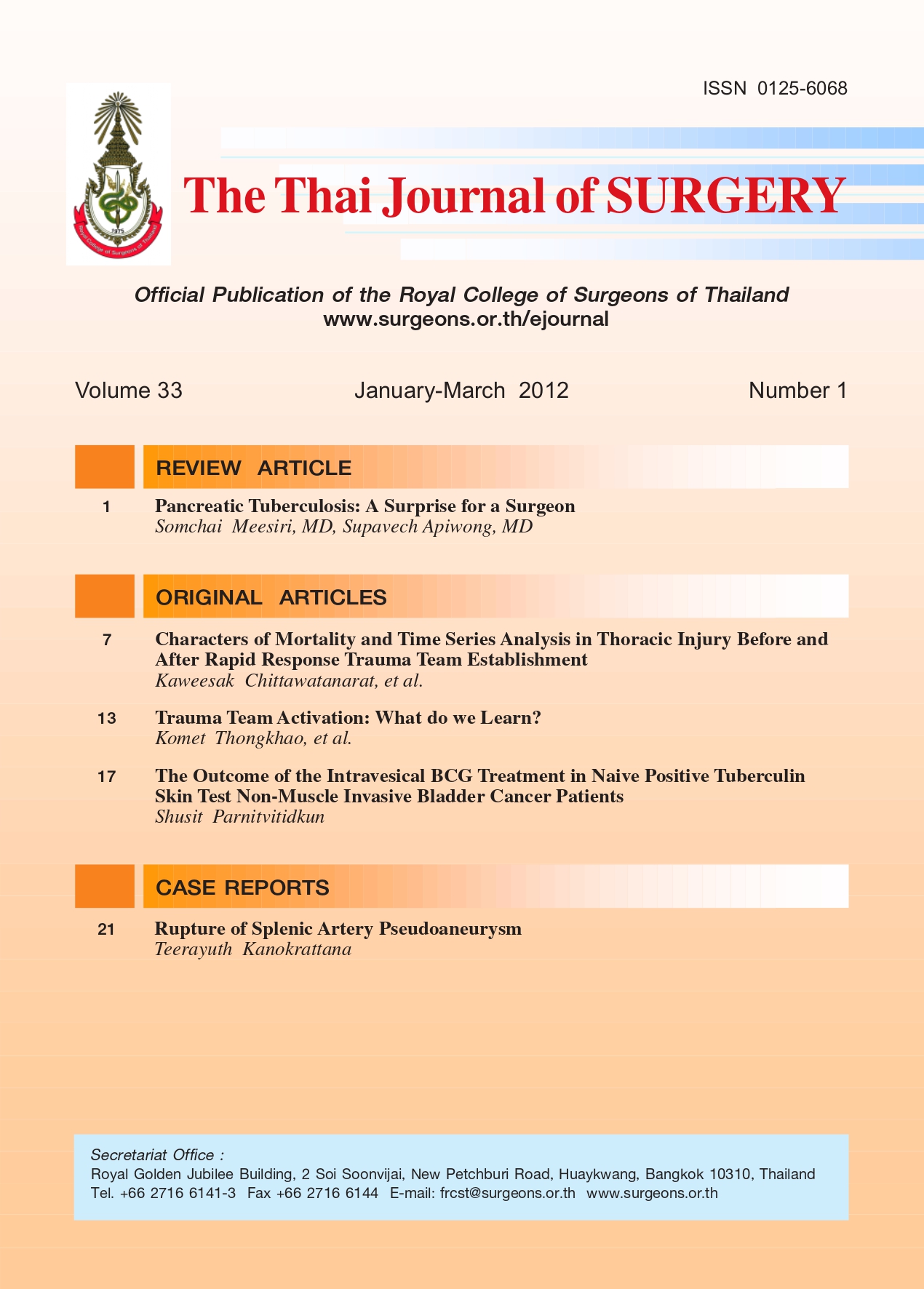Trauma Team Activation: What do we learn?
Keywords:
Trauma team activation criteria, TriageAbstract
Background: The treatment outcome of severe trauma victims can be improved by the early presence of the trauma team under leadership of an expert trauma surgeon in the emergency room. The criteria for trauma team activation was the presence of patients at risk or need critical care. This study aimed to evaluate a trauma team activation criteria after implementation at the Songklanagarind Hospital, a level I trauma center.
Materials and Methods: Adult trauma patients (age ≥ 15 years) who directly came to Songklanagarind Hospital from January to December 2009 and met at least one of the trauma team activation criteria were enrolled. The criteria consisted of (I) penetrating injury to the chest or the abdomen, (II) systolic blood pressure ≤ 90 mmHg, (III) pulse rate > 120 beat per minute, (IV) respiratory rate <10 or > 30/min, (V) severe head injury (GCS score ≥ 8) and (VI) trauma arrest. Data were retrieved from the trauma registry and descriptive reports.
Results: One hundred and fifty-three patients met inclusion criteria. The mean age was 33 ± 13 years. The majority of patients were male (85%) and the average ISS was 18. The most common criteria for activation was pulse rate > 120 bpm (37%). The activation occurred in 52 percent of patients who met the criteria and the surgeon presented at resuscitation room in 75 percent. The procedures which commonly performed in the ER were endotracheal intubation and central venous catheterization (43%). Fifty-seven patients (37%) received emergency operation and the most common operation was exploratory laparotomy (23%). Rate of emergency operation was high in patients presented with hypotension (61%) followed by penetrating torso injury (48%). The mortality rate was high in severe head injury patients (43%). All patients who present with cardiac arrest died. The average length of hospital stay was 14 days. One hundred and two patients (67%) survived until discharge.
Conclusions: The majority of severely trauma patients who met the trauma team activation criteria survived until discharge. The activation occurred in about half of them and the surgeon can present in the emergency department in the majority of cases at our hospital In 2004 the authers organized a regional health care system to develop pre-hospital health care system. Rate of emergency operation was high in patients presented with hypotension or penetrating torso injury. Trauma arrest and severe head injury patients had high mortality rate. Good compliance with the criteria may translate to improved outcomes.
References
2. Rainer TH, Cheung NK, Yeung JH, Graham CA. Do trauma teams make a difference? A single cetre registry study. Resuscitation 2007; 73:374-81.
3. Committee on Trauma of American College of Surgeons. Resources for optimal care of the injuried 1993. Chicago, IL: American College of Surgeons, 1993.
4. Smith J, Caldwell E, Sugrue M. Difference in trauma team activation criteria between hospitals within the same region. Emerg Med Australas 2005; 17:480-7.
5. Demetriades D, Sava J, Alo K, Newton E, Velmahos GC, Murray JA, et al. Old age as a criterion for trauma team activation. J Trauma 2001; 51:754-6.
6. Franklin GA, Boaz PW, Spain DA, Lukan JK, Carrillo EH, Richardson JD. Prehospital hypotension as a valid indicator of trauma team activation. J Trauma 2000; 48:1034-7.
7. Boyle MJ, Smith EC, Archer F. Is mechanism of injury alone a useful predictor of major trauma? Injury 2008; 39:986-92.
8. Esposito TJ, Offner PJ, Jurkovich GJ, Griffith J, Maier RV. Do prehospital trauma center triage criteria identify trauma victims? Arch Surg 1995;130:171-6.
9. Tinkoff GH, O’Connor RE. Validation of new trauma triage rules for trauma attending response to the emergency department. J Trauma 2002;52:1153-8.
10. Chuathong A, Sangthong B, Thongkhao K, Vasinanukorn P. Survival after emergency room thoracotomy in trauma patients. Songkla Med J 2007;25:431-6.
Downloads
Published
How to Cite
Issue
Section
License
Articles must be contributed solely to The Thai Journal of Surgery and when published become the property of the Royal College of Surgeons of Thailand. The Royal College of Surgeons of Thailand reserves copyright on all published materials and such materials may not be reproduced in any form without the written permission.



